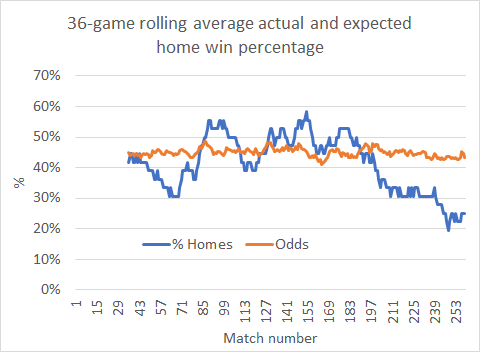So lots of talk about the loss of home advantage in the Bundesliga. Here& #39;s the 36-game rolling average home win percentage (36 because that& #39;s how many games have been played behind closed doors, including 1 before lockdown). Vertical grey line delineates the change.
Is this significant? Well, the 224 games played with spectators saw 43.9% home wins. Based on fair closing @Pinnacle odds, the expectation was 45.1% with a standard deviation (from a 10,000-run Monte Carlo) of 3.1%. So actual percentage well within statistical error.
Ignore chart title. It really is 36-game, I redid it and forgot to change the title.
The standard deviation in the 36-game running average home win percentage across those 224 games was 7.5%. Randomising results via the 10,000-run Monte Carlo yields a means standard deviation of 6.8% and a standard deviation in that of 1.7%.
So again actual record within is within statistical error, based on Pinny& #39;s closing odds model.
Now we turn to the last 36 games. Home win percentage is 27.7%. This is a full 2.5 standard deviations away from expected mean based on expected variance over 36-games.
Now we turn to the last 36 games. Home win percentage is 27.7%. This is a full 2.5 standard deviations away from expected mean based on expected variance over 36-games.
If we assume we& #39;d have expected a drop in home win percentage (1-tailed test) then the associated p-value is about 0.5%. That& #39;s quite significant. So I will stick my neck out here and say, yes, lack of crowds has reduced home team advantage.
Interesting question is why? Probably numerous factors, three most obvious being reduced referee bias, loss of "12th-man" and reduced loss aversion (the idea being that home teams hate losing more in front of home fans).
And based on the odds for the last 36 games, the market hasn& #39;t yet caught up.

 Read on Twitter
Read on Twitter



